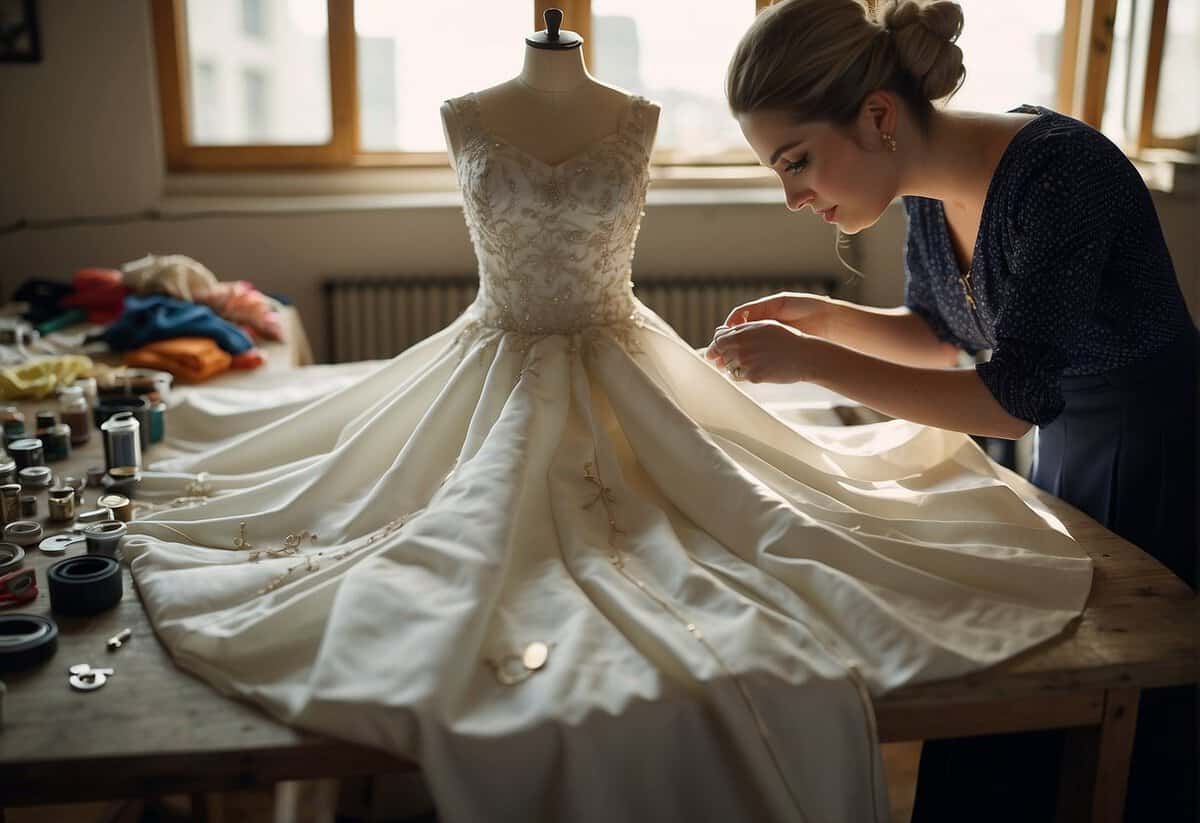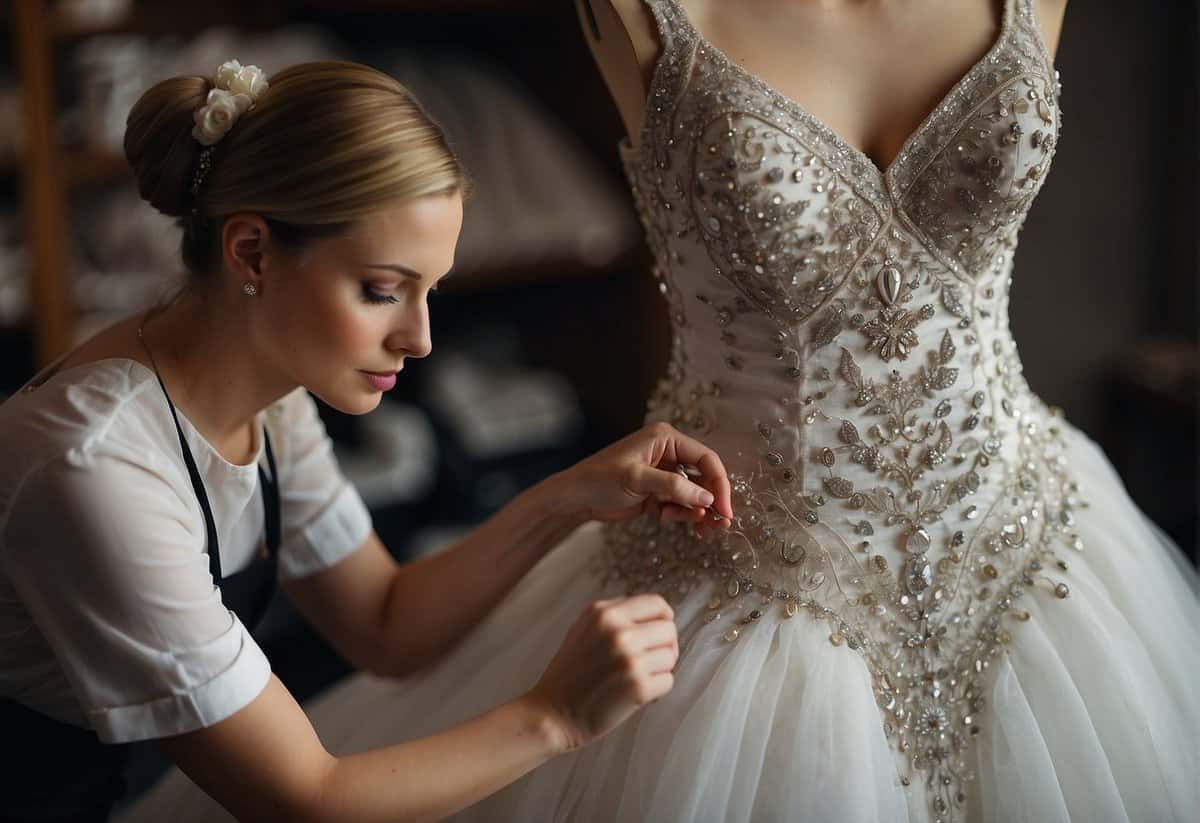How Much Should Wedding Dress Alterations Cost? Understanding Your Budget
When planning your wedding, the fit of your wedding dress is essential for feeling confident and comfortable on your big day. The cost of wedding dress alterations can vary widely, depending on several factors such as the complexity of the desired changes, the type of fabric of your gown, and the timeline within which you need the alterations completed. Generally, brides can anticipate spending anywhere from $150 to over $800 for adjustments, with more extensive alterations potentially increasing the cost.

It’s crucial to account for alteration costs in your wedding budget to avoid any surprises. On average, simple alterations like hemming the length or adjusting the sides may fall on the lower end of the cost spectrum, whereas intricate modifications and customization can contribute to a higher price tag. By understanding the common types of wedding dress alterations and preparing properly for fitting appointments, you will be better equipped to manage time and finances.
Key Takeaways
- Alteration costs can range widely; expect to spend between $150 and $800 on average.
- Include alteration expenses in your overall wedding attire budget to prevent unexpected costs.
- Thorough preparations for fittings ensure alterations meet your needs within the desired timeframe.
Understanding Wedding Dress Alteration Costs

As you approach your wedding day, you’ll find that the perfect fit of your gown is instrumental in looking and feeling beautiful. Knowing what to budget for wedding dress alterations helps in managing your overall wedding expenses.
Average Cost Breakdown
On average, alteration costs for a wedding dress can range from $150 to $800. Basic alterations—such as hemming a dress, taking in sides, or adding bra cups—represent the lower end of this spectrum. For instance, hemming a dress can cost between $40 and $100, while modifying the sides might set you back $20 to $50. Some bridal shops offer a flat alteration fee, which can simplify your budgeting, but this could be higher than paying à la carte fees for only the services you need.
Factors Influencing Cost
The cost of wedding dress alterations can be influenced by several factors. The fabric of your dress impacts the cost, as delicate materials like lace or silk require more care and expertise. Designs with intricate beading or other embellishments may increase the price due to the meticulous attention they demand.
If you need your dress in a hurry, be mindful that rush charges may apply, pushing the overall price higher. Additionally, choosing a highly skilled professional seamstress or tailor can offer peace of mind but often comes with a higher price tag compared to less experienced providers.
Remember, the key to managing alteration costs effectively is to factor these expenses into your budget from the outset and communicate clearly with your chosen professional about your specific alteration needs.
Types of Wedding Dress Alterations

When you select your dream wedding gown, the alterations process tailors the fit specifically to you, ensuring every detail from the hem to the bustle is perfect.
Common Alteration Services
Hemming: One of the most frequent alterations, adjusting the length of your gown ensures it’s the perfect length for you. The cost for hemming can vary depending on layers and fabric.
Taking in/out side seams: To ensure your dress fits your bust, hips, and waist seamlessly, a seamstress or tailor may adjust the side seams of the bodice or skirt.
Adding bustles: A bustle lifts your train off the ground post-ceremony. The method of bustling affects the cost of your alterations.
Adjusting sleeves and straps: For gowns with sleeves or straps, these features may need lengthening or shortening.
Resizing the bust area: Whether adding bra cups or taking in the area around the bust, this customization ensures your top fits without issues.
Neckline reshaping: From a simple scoop to a sweetheart, altering the neckline customizes the dress’s look to match your style.
Specialized Customizations
These alterations personalize your dress beyond standard sizing adjustments.
Adding sleeves or straps: You might want to add sleeves to your strapless gown for aesthetic reasons or seasonal comfort.
Custom redesigning: A beloved family heirloom or a gown in need of an update might require a complete redesign, which can involve altering the lace, beading, or creating new embellishments.
Custom bridal veils: Matching your veil to your gown may include customizations, with its cost varying based on the complexity.
Lace and beading work: Changing or adding intricate lace patterns or beading typically involves handwork, influencing both the time and cost.
Each alteration or customization plays a role in making your gown as unique as your big day, and professional bridal alterations will help achieve the perfect fit and style.
Preparing for Fitting Appointments

As you approach your fitting appointments, remember that preparation is essential to ensuring your dress is perfectly tailored for your wedding day. These appointments are opportunities to make the necessary adjustments, so your dress fits flawlessly, preventing any last-minute wardrobe malfunctions.
What to Bring
- Dress: Naturally, your wedding dress is the main item to bring. If you’re still wedding dress shopping, bring a dress with a similar silhouette to understand how alterations would work.
- Shoes: The exact shoes you intend to wear on your special day are crucial for accurate measurements for hemming.
- Undergarments: The right undergarments can drastically change the fit of your dress, so choose them before your fitting.
- Accessories: If you’ve settled on your accessories, bring them along to see the complete look.
Scheduling Your Fittings
- First Appointment: Generally, schedule your initial dress fitting appointment at least 6 weeks before your wedding day.
- Number of Fittings: Most brides require multiple rounds of fittings, often 2-3, to fine-tune the fit.
- Professional Seamstress: Book these appointments with a professional seamstress, preferably one associated with your bridal boutique.
- Consultations: Use the fittings for consultations on any further wedding alterations that may enhance your look or comfort.
Final Touches and Considerations

When it’s nearly your wedding day, ensuring your dress achieves a flawless fit is paramount. During your final dress fitting appointment, focus on the detailing of your gown, which may include delicate fabrics, intricate beading, or lace appliqués. Here’s what to consider:
- Beading and Embellishments: If your dress features beadwork or pearls, confirm everything is securely attached.
- Lace and Hemming: Pay special attention to lace hems and layers, making sure they’re even and intact after hemming.
- Bustle Points: Your gown’s bustle points should be tried and tested, so they hold up during the reception.
If you’re customizing your gown or transforming a family heirloom gown, last-minute adjustments may be needed. These can range from adding a corset back for better sizing to adjusting button placements.
Remember, alterations can go beyond basic hemming. Here’s a quick guide to potential bridal salon costs:
| Alteration Service | Estimated Cost |
|---|---|
| Hemming | $40 – $100 |
| Adding Bustle | $55 – $200 |
| Beadwork Repairs | $50 – $150 |
| Sleeves Adjustments | $30 – $100 |
Keep in mind, flat fees may apply, and bridesmaid dress alterations cost could differ. It’s crucial that your wedding shoes are the exact height you’ll wear to ensure a proper fit.
Finally, examine the fabric type. Delicate fabrics like silk or chiffon require extra care, while lace appliqués need careful handling to avoid snags. Confirm all is in place, so on your big day, your focus can be on celebrating, not adjusting your dress!
Frequently Asked Questions

When planning your special day, it’s important to consider how wedding dress alterations fit into your overall budget. From simple hems to intricate beadwork, the cost can vary, so understanding the basics helps you plan effectively.
What is the average price range for altering a wedding dress?
Alterations for a wedding dress can typically cost anywhere from $150 to $800. This cost range is dependent on the complexity of the alterations you require and the nature of the dress’s design.
Can the cost of wedding dress alterations vary significantly by location?
Yes, the cost of wedding dress alterations can vary quite a bit based on your location. Metropolitan areas may charge more due to higher overhead costs, compared to smaller towns or rural areas.
What factors influence the price of wedding dress alterations?
Several factors affect the price, including the type of fabric, the extent of the alterations needed, and the addition of any bespoke detailing, such as lace or beading.
Why can alterations for a wedding dress be a higher cost than for other types of dresses?
Wedding dresses often have delicate fabrics and detailed embellishments, requiring a high level of skill and time to alter. Additionally, the fit of a wedding dress is typically more precise than that of casual wear, contributing to a higher cost.
When is the best time to have a wedding dress altered before the big day?
Ideally, you should plan for 2 to 3 fittings spread over several months before your wedding day. Starting alterations too late might rush the process and potentially compromise the quality of alterations.
How can you budget for wedding dress alteration expenses?
Begin by doing research to get a sense of average costs. Once you have an understanding, include a line-item in your wedding budget specifically for alterations to ensure you’re prepared for the costs involved.

